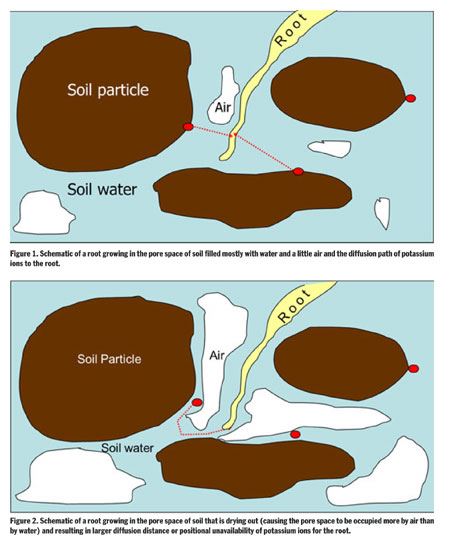Water Stress And Nutrient Deficiency
URBANA, ILL.
The dry conditions persisting over much of
Illinois and the Midwest are causing all
sorts of nutrient deficiency problems to
show up. Unfortunately, little besides rain can
fix them. Foliar or soil application of nutrients
will not solve a deficiency, and neither one is
recommended at this time.
Many cornfields show potassium deficiency
even though adequate fertility is present in the
soil. One question being asked is why deficiency
of potassium is showing up in corn more than
deficiency of any other nutrient.
There could be several reasons, but I believe
the most likely one is that, unlike with nitrogen
and phosphorus, large amounts of potassium
are taken up rapidly by corn early in development.
Soon after the V12 development stage,
corn has already taken up half of all the potassium
it will need, and by the R1-R2 development
stages, it has taken up all it will need (around
170 lb of K2O/acre). This is in contrast with nitrogen
and phosphorus, which continue to be
taken up until sometime after the dent stage
(R5). Also, unlike nitrogen, which moves freely
over large distances in the soil solution, phosphorous
and potassium can only move at most
a few short millimeters in the soil solution,
which causes these nutrients to become positionally
unavailable to the crop when the soil
dries out.
I believe some illustrations may help show
what happens to nutrient availability as soil
dries out. Figure 1 shows a root growing in the
pore space of the soil, which is occupied by
water and air. Plant-available potassium ions
(represented by the red dots) are dissolved in the
soil water or are attached to soil particles ready
to come into solution as the plant needs them.
When there is sufficient water in the soil, the
potassium ions dissolved in water have to travel
(by diffusion) only a very short distance (represented
by the dotted arrow) to be taken up by
the crop. As the soil dries out and pore space becomes
largely occupied by air (Figure 2), the
potassium ion has to diffuse across a larger distance
to reach the root because it cannot diffuse
through air.
An increase in the time of diffusion can have
large detrimental consequences during corn vegetative
stages, when potassium demands are
large. Under dry conditions the soil is simply unable
to keep up with the crop demand, even
though there might be sufficient potassium in
the soil. Phosphorus availability can be limited
in a similar way, but because demands are not
as high over a relatively short period and the
total amount of phosphorus needed is lower
than for potassium (about 80 lb P2O5/acre), the
plant probably can still obtain enough phosphorus
and the crop is less likely to show phosphorus
deficiency symptoms.

Finally, in some situations as the soil dries out
the distance might become so large that the ion
is not available to the plant at all (as represented
by the ion closest to the bottom of Figure 2). This
situation is what we are seeing in many fields,
which have adequate potassium levels, but as
far as the plant is concerned, the nutrient is too
far out of reach.
While irrigation is the only option for solving
the drought problems we are seeing in much of
the state, this year can teach us some important
lessons. I recommend for the future that you
minimize the effect of drought by ensuring that
whatever water is present in the soil is protected
to be used by the crop. Some farmers have seen
firsthand this year how much water weeds can
take up when not treated early in the season.
Similarly, too much tillage has in some situations
caused unnecessary water evaporation
from the soil, and those fields are running out
of water sooner than fields that were managed
more carefully. Δ
DR. FABIÁN FERNÁNDEZ: Assistant Professor,
University of Illinois